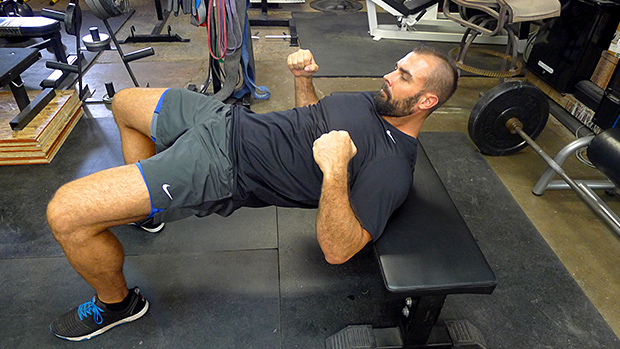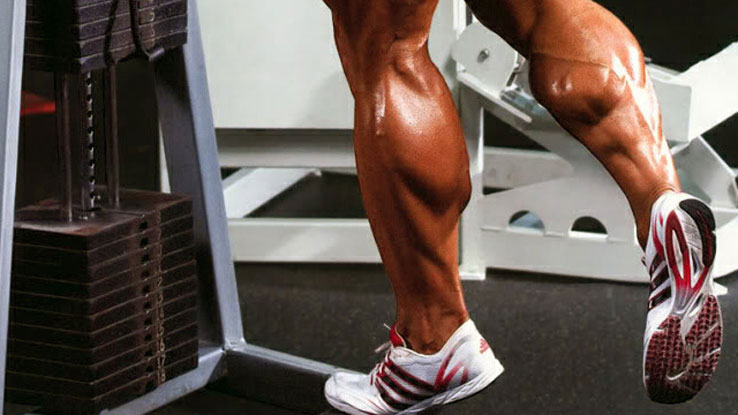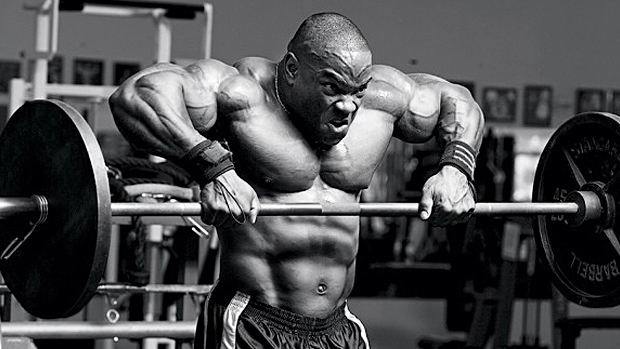When strength coach Bret Contreras' first article, Dispelling the Glute Myth debuted at Testosterone, none of your humble editors knew what to make of him except that clearly, the guy sure knew his way around an ass.
[Insert requisite prostate exam / sex acts banned in Utah joke here.]
Editor-in-chief TC was the first to notice that "The Glute Guy" may be more than a one-trick pony after seeing the way Contreras dealt with the comments and criticism in that article's discussion thread. He was enthusiastic yet unflappable, and backed up his points with plenty of evidence without sounding like another keyboard commando. In short, he sounded like a pro.
When we asked Contreras to weigh in with 16 Training Tips, he jumped at the chance to show Testosterone readers that he's more than just a butt and hamstring connoisseur. Turns out, the former math teacher turned trainer knows a lot about the iron, period.
Crack out your number 2 pencil and prepare to take some notes. Class is about to begin. – Bryan
The is the essence of the Westside approach. For a quick boost in deadlift strength, you might want to try the front-squat iso-hold and weighted static hang.
The front squat iso-hold is performed by doing a walkout with 133% of your 1-RM front squat and holding it for time. It's a brutal upper back exercise that strengthens the thoracic extensors and leads to increased upper back strength, which is the limiting factor in many deadlifters.
The weighted static hang is performed by suspending lots of 45 lb plates between your legs via a dip belt and hanging from a chin up bar with either a pronated, neutral, or mixed grip. This method is much more "lower-back friendly" than static barbell holds and can improve grip strength, which does wonders for those with weak grips and subsequent inferior bar acceleration.
Don't try to have too many mini-goals. Try to choose hypertrophy, strength, conditioning, or esthetics. The "jack of all trades" approach is fine if that's what you're after, but you can't reach either maximum strength or maximum hypertrophy by going that route. Look at your routine, and see if you're trying to include everything but the kitchen sink. If so, you're probably spinning your wheels.
Most people's goals are related to strength, hypertrophy, power, or conditioning. Strength plays a huge role in every one of those qualities. If your goal is max hypertrophy, get strong in a variety of rep ranges, not just the 8-12 rep "hypertrophy range."
They don't know enough to "individualize" and create their own. Use one that's proven to work for the masses. Bill Starr, Mark Rippetoe, and Jim Wendler have provided some good starting points.
Beginners also need to master bodyweight squats before putting a bar on their back, and learn how to hip hinge (move at the hips) before loading plates on the bar for deadlifts.
Learn both sides of an issue and determine your own stance. Not trying to sound cocky, but I could take either stance of an issue and make a fool out of a typical trainer or lifter because I know the science and arguments behind each topic. I can find journal evidence, anecdotal evidence, and work the science to support nearly anything I want. This doesn't make me right.
Are sit-ups, crunches, and hanging leg raises damaging lumbar discs? Once "corrected" do you need to continue doing static stretching, mobility work, or activation work? Does core stability work and unilateral work make you lift heavier bilateral loads after a certain point? Does sitting ruin your posture? Does sitting lead to back pain?
Does regularly performing full range strength exercises such as full squats, Romanian deadlifts, Bulgarian squats, dips, and chins prevent flexibility losses and negative postural adaptations? Does a lifter who is training for strength need to have an advanced "general warm-up?"
Assuming one has proper mobility, does correcting motor patterns have more to do with strengthening muscles or learning and practicing proper form?
I think I know the answer to these questions, but the answers aren't "cut and dry." I know one thing: I'm unique in that I don't pretend to know the answers to all these questions. If top researchers don't know the answers then I'm pretty sure strength coaches don't know the answer, either.
I never thought extreme measures of High Intensity Training or High Frequency Training would work, but they do. I've done one full-body routine every five days and saw good results. I've done squats, bench, and deadlifts six days per week (there are ways to make it work) and saw great results.
If you're too close-minded to try something new, you'll never really understand how to manipulate training variables and how the body responds to various stimuli. The only thing you can be close-minded about is "Superslow Training." That shit's retarded.
For years I'd have my training partner try to follow full body routines and lower/upper routines only to finally accept the fact that he responds best to typical bodybuilding methodology.
If I hit a muscle group once per week I detrain, lose strength, and get smaller. He does well with this stimuli. He's a natural lifter too in case you're wondering, but also genetically "gifted." The point being, you can't let your personal experiences fool you into believing that what works for you must work for everyone.
This applies to flexibility, mobility, stability, strength, power, speed, and conditioning. The thing is that most people aren't interested in simply "maintaining," which is actually a good thing. Drive and determination separate the men from the boys. If you ever find yourself bogged down and overworked, don't ever quit training altogether. Do one full body workout every five days and you'll keep your gains.
Clean it up, reduce calories, etc. Don't keep adding more and more conditioning work to your routine. Save your energy and dedicate your body's resources to maintaining or even building strength, which will cause your body to hold onto muscle while losing weight.
You want to lose fat, not muscle, so you need to stay strong while losing weight. Too many people are doing way too much HIIT, complexes, Tabatas, circuits, and cardio.
Strength balances are extremely underappreciated. You need to have balanced strength across the various vectors for optimal joint centration and lifting longevity. Benching vs. rowing strength, squatting vs. hip thrusting strength, military press vs. chinning strength, squatting vs. deadlifting strength, and benching vs. military press strength should all be examined.
Bilateral to unilateral strength ratios are good to look at too, such as squatting vs. Bulgarian squat strength, as is barbell to dumbbell strength ratios like bench press vs. dumbbell bench press strength.
Of your heavy squats, bench presses, and deadlifts and ask experienced lifters for feedback via a forum you trust. Unfortunately, most guys are too insecure or lazy to ever go this route. Most people simply don't know that their form sucks.
However, most people also don't know how form will vary due to anthropometry and anatomy. If you watch films of bodybuilders, powerlifters, strongmen, and Olympic lifters, you'll notice that they all adopt a particular style that works for them. There are definite guidelines, but there are also exceptions to the rules.
Don't get carried away with "activating the right muscles." You can squat with pure anterior weight shift and forward knee bend and feel it all in the quads, but you won't be lifting for very long as your knees will eventually give out. You must learn how to properly distribute forces across the various joints during compound lifting so they share the load and spare tissues and structures. The tortoise always beats the hare in the long run.
If you watch videos of big and strong lifters such as Ronnie Coleman and Chuck Vogelpohl, you'll notice that they could "turn everything on" when needed.
Furthermore, know the right tool for the job: TRX rows, push ups, pistols, single leg Romanian deadlifts, single leg glute bridges, goblet squats, kettlebell swings, Turkish get ups, cable woodchops, slideboard leg curls, front planks, and side planks are great exercises that have their place, but if your goal is maximum hypertrophy and strength, you need to up the ante. In the muscle-building kingdom, the mighty barbell will stay emperor for eternity.
Who could full squat 315 x 10, conventional deadlift 405 x 10, walking barbell lunge 225 x 10, bench press 315 x 10, weighted chin 90 x 10, weighted dip 135 x 10, military press 185 x 10, and row 275 x 10.
The fat powerlifter type couldn't pull this off due to the weighted chins and dips. The upper body only guy couldn't pull this off because he wouldn't have the lower body strength. Aiming for these strength feats encourages low bodyfat levels and big muscles all over. I wonder what percentage of male lifters ever reach this level of strength; my guess would be one in ten thousand.
Some say that they prefer pull-throughs since it's a similar motion. Listen, the hip thrust is to the pull through as the bench press is to the standing cable chest press; good to do every once in a while, but a stable base and a barbell maximizes activation.
Some say that activation isn't important. Whoever tells you that doesn't know what they're talking about. Assuming a lifter isn't juicing, all neuromuscular adaptations start with tension on the muscles, which is highly correlated with activation. Full squats maximize quad activation but leave room on the table for hamstring and glute activation.
Deadlifts maximize hamstring activation but leave room on the table for quad and glute activation. Hip thrusts maximize glute activation but leave room on the table for quad and hamstring activation. The three are synergistic in this regard.
Some say that hip thrusts are a "pussy exercise" or are "too embarrassing." Are you embarrassed to have sex? Last time I checked, thrusting was manly, moving a barbell loaded with lots of plates through a full range of motion was manly, and banging a hot chick who lusted after your glutes because her ex-boyfriends all had chicken legs was manly too.
If you're happy with your level of glute development, then don't hip thrust. But if you need more glute, then thrust away.
Hitting each muscle once per week is sub-optimal for most natural lifters. For example, doing deadlifts and back extensions on back day and glute ham raises and good mornings on leg day has you working hamstrings twice per week.
Doing close grip bench and dips on arm day has you hitting the pecs twice per week. The shoulders typically get hit quite often and don't need more added frequency.
Learn from a variety of sources. Learn from:
- lifting weights
- listening to other big and strong people
- listening to coaches and trainers who help people get big and strong
- science and journals
Any single method of learning on its own is sub-optimal. You can even learn by reading articles like this one. Well, at least I hope you can!




